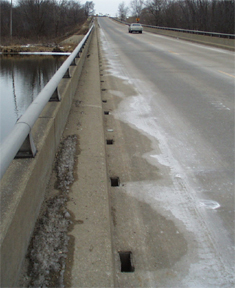 When faced
with a winter storm, cities deploy trucks to cover city streets with salt. The
nation’s favorite deicer, however, pollutes freshwater, and new research
suggests the effects of road salt may be more widespread than previously thought.
When faced
with a winter storm, cities deploy trucks to cover city streets with salt. The
nation’s favorite deicer, however, pollutes freshwater, and new research
suggests the effects of road salt may be more widespread than previously thought.
This bridge, which spans the Rock River near the Wisconsin-Illinois border, shows how road salt can be swept into freshwater systems. Pollution from deicers is an increasing problem for rural areas, as well as urban regions. Image courtesy of George Lisensky, Beloit College.
Researchers gathered 30 years of road and water data from sites around the northeastern United States and confirmed that as the amount of pavement increased, so did salt, or chloride, levels in groundwater. Peter Groffman of the Institute of Ecosystem Studies, and co-author of the research published in the Sept. 20 Proceedings of the National Academy of Sciences, says they also were surprised to find high chloride levels year-round in both rural and urban regions.
“It wouldn’t be a surprise for Baltimore, or any other city when it snows, to find high chloride concentrations,” Groffman says. “But even sites on the rural-suburban fringe, with very low impervious surface, are showing a significant elevation of chloride.” The results suggest that the number of streams around the country affected by chloride pollution could be significant.
In addition to the Baltimore metropolitan area, watersheds in rural locations throughout Maryland, New York and New Hampshire were polluted with chloride, some reaching salinity levels close to 25 percent of seawater. Even areas that did not increase the amount of salt on their roads still saw increases in chloride concentrations, which remained high throughout the year. “That suggests that somehow, salt is building up in the environment, and so we’re getting these increases in [salt] concentrations over time,” Groffman says.
One idea is that the salt is accumulating in shallow groundwater, or alternatively, solid salt deposits could be accumulating under or near streams, Groffman says. Understanding how the roadway salt accumulates in water will help researchers mitigate potential future freshwater ecosystem disruption.
Ken Yetman, a biologist at the Maryland Department of Natural Resources, says that he was not surprised by the results of the study. Urban areas, with large amounts of paved surfaces, he says, face the brunt of the pollution problem posed by deicers, “but there are ways of reducing the impact.”
A filtration system called a “rain garden” is one way that Yetman says pollutants can be reduced from groundwater. Runoff is directed toward a garden of native plants, and pollutants are then filtered out naturally before they reach groundwater.
In the meantime, “there are not many good alternatives to salt as a deicer,” Yetman says. So, when winter arrives, expect to see the salt trucks emerge in full force.

